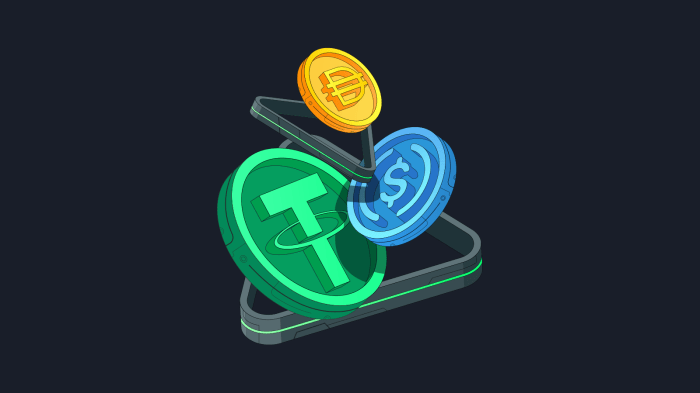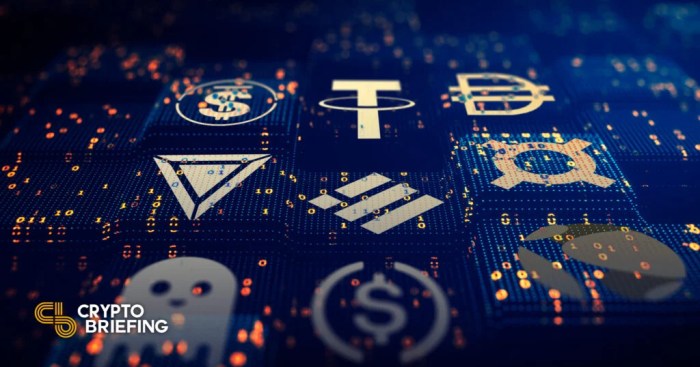The Future of Stablecoins and Their Role in Crypto takes us on a wild ride through the world of digital currencies, shedding light on the significance of stablecoins in the ever-evolving crypto landscape. Brace yourselves for a journey filled with insights and revelations that will leave you wanting more.
From the basics of stablecoin concepts to the intricate web of regulatory challenges, this exploration promises to unravel the mysteries surrounding stablecoins and their impact on the future of finance.
Overview of Stablecoins

Stablecoins are a type of cryptocurrency that are designed to have a stable value, typically pegged to a fiat currency like the US Dollar or a commodity like gold. This stability is achieved through various mechanisms such as collateralization, algorithmic control, or a combination of both.
Examples of Popular Stablecoins
- Tether (USDT): Tether is one of the most widely used stablecoins in the market, with its value pegged 1:1 to the US Dollar. It is often used as a trading pair on many cryptocurrency exchanges.
- USD Coin (USDC): USD Coin is another popular stablecoin that is backed by US Dollars held in reserve. It is regulated and audited regularly to ensure transparency.
- DAI: DAI is a decentralized stablecoin that is created on the Ethereum blockchain through the use of smart contracts. It maintains its stability through overcollateralization.
Importance of Stablecoins in the Cryptocurrency Ecosystem
Stablecoins play a crucial role in the cryptocurrency ecosystem for several reasons:
- Price Stability: Stablecoins provide a stable store of value in a market known for its volatility, allowing users to hedge against price fluctuations.
- Facilitate Trading: Stablecoins are often used as trading pairs for other cryptocurrencies, enabling seamless and efficient trading without the need to convert back to fiat currencies.
- Remittances: Stablecoins offer a cost-effective and fast way to send cross-border payments, especially in regions with limited access to traditional banking services.
- Smart Contracts: Stablecoins can be integrated into smart contracts for various applications like decentralized finance (DeFi), lending, and tokenized assets.
Types of Stablecoins

Stablecoins come in different forms, each with its own unique characteristics and mechanisms. Let’s delve into the three main types: centralized, decentralized, and algorithmic stablecoins.
Centralized Stablecoins
Centralized stablecoins are issued and controlled by a single entity, typically a company or financial institution. Examples include USDT (Tether) and USDC (USD Coin). These stablecoins are backed by reserves of fiat currencies like the US dollar, which are held by the issuing company. Centralized stablecoins offer stability and liquidity but are subject to regulatory risks and the solvency of the issuing entity.
Decentralized Stablecoins
Decentralized stablecoins operate on blockchain networks without a central authority. DAI and sUSD are examples of decentralized stablecoins. These stablecoins are collateralized by other crypto assets, such as Ethereum or Bitcoin, locked in smart contracts. Decentralized stablecoins provide transparency and censorship resistance, but they can be affected by market volatility and liquidation risks.
Algorithmic Stablecoins
Algorithmic stablecoins rely on algorithms to maintain price stability without the need for collateral backing. Examples include Ampleforth and Terra’s UST. These stablecoins use mechanisms like supply adjustments and incentives to regulate their value. Algorithmic stablecoins offer decentralization and scalability, but they are susceptible to price manipulation and algorithmic failures.
In conclusion, each type of stablecoin has its own set of advantages and drawbacks. Centralized stablecoins provide stability but are centralized and reliant on the issuer’s trustworthiness. Decentralized stablecoins offer transparency but are exposed to market risks. Algorithmic stablecoins aim for decentralization but face challenges in maintaining stability and avoiding manipulation.
Role of Stablecoins in Crypto Adoption: The Future Of Stablecoins And Their Role In Crypto
Stablecoins play a crucial role in driving mainstream adoption of cryptocurrencies by providing a more stable and predictable value compared to other volatile digital assets. This stability makes them more appealing to everyday users and businesses looking to enter the crypto space.
Reducing Volatility for Investors, The Future of Stablecoins and Their Role in Crypto
Stablecoins act as a safe haven for investors during times of market uncertainty or extreme price fluctuations. By pegging their value to a stable asset like the US Dollar or other fiat currencies, stablecoins offer a reliable store of value and a hedge against market volatility.
- Investors can easily convert their crypto holdings into stablecoins to protect their funds from sudden market crashes or price swings.
- Stablecoins also provide a convenient way to park profits and wait for better investment opportunities without the risk of losing value due to market fluctuations.
- Moreover, stablecoins offer liquidity and stability in decentralized finance (DeFi) platforms, enabling users to engage in various financial activities without worrying about price volatility.
Bridging Traditional Finance with Blockchain Technology
Stablecoins serve as a bridge between the traditional financial system and the innovative blockchain technology, enabling seamless cross-border transactions, faster settlements, and lower transaction fees.
Stablecoins eliminate the need for intermediaries in financial transactions, reducing costs and increasing efficiency in cross-border payments and remittances.
- By offering a stable and fast medium of exchange, stablecoins encourage wider adoption of blockchain technology in various industries, including e-commerce, gaming, and supply chain management.
- Stablecoins also pave the way for the tokenization of real-world assets, such as real estate, commodities, and securities, making them more accessible and tradable on blockchain platforms.
- Overall, stablecoins contribute to the integration of cryptocurrencies into the mainstream financial ecosystem, offering a reliable and efficient means of value transfer and storage.
Regulatory Challenges and Compliance

In the world of stablecoins, regulatory challenges and compliance are crucial aspects that issuers must navigate to ensure the legality and sustainability of their projects.
Regulatory Challenges Faced by Stablecoin Issuers
- One of the main regulatory challenges faced by stablecoin issuers is the lack of clear guidelines and regulations specifically tailored to stablecoins.
- Regulatory bodies often struggle to categorize stablecoins, leading to uncertainty around how they should be treated from a legal standpoint.
- Issues related to money laundering, fraud, and consumer protection also pose significant challenges for stablecoin projects.
Impact of Regulatory Uncertainty on Stablecoin Growth
- Regulatory uncertainty can hinder the growth of stablecoins by creating a sense of instability and risk among investors and users.
- Without clear regulations, stablecoin issuers may find it difficult to attract traditional financial institutions to partner with them, limiting their reach and adoption.
- Uncertainty around compliance requirements can also deter potential users from engaging with stablecoin projects, impacting their overall growth and success.
Compliance Measures for Stablecoin Projects
- Stablecoin projects must prioritize compliance with existing financial regulations to ensure their operations are legal and sustainable.
- Implementing robust know-your-customer (KYC) and anti-money laundering (AML) procedures is essential to prevent illicit activities and maintain regulatory compliance.
- Regular audits, transparency in reporting, and collaboration with regulatory bodies can help stablecoin projects demonstrate their commitment to compliance and build trust with stakeholders.
Innovation and Future Trends
Innovation in the stablecoin space is paving the way for new and exciting use cases beyond traditional finance. These digital assets are not only revolutionizing the way we transfer value but also opening up a world of possibilities for various industries and sectors.
Innovative Use Cases for Stablecoins
- Facilitating cross-border payments: Stablecoins enable instant and low-cost international transactions, making them ideal for remittances and global commerce.
- Tokenization of assets: Stablecoins can represent ownership of real-world assets like real estate, art, or commodities, providing fractional ownership and increased liquidity.
- Decentralized finance (DeFi) applications: Stablecoins are the backbone of many DeFi platforms, offering users access to lending, borrowing, and trading services without the need for traditional banks.
Impact of CBDCs on the Stablecoin Market
The rise of Central Bank Digital Currencies (CBDCs) poses both challenges and opportunities for existing stablecoins. While CBDCs could potentially provide a secure and regulated alternative, they may also impact the demand for private stablecoins.
Future Trends in Stablecoin Development
- Enhanced scalability and interoperability: Future stablecoins are likely to focus on improving scalability to handle increased transaction volumes and cross-chain interoperability for seamless transfers between different blockchain networks.
- Integration with IoT and smart contracts: Stablecoins could be integrated with Internet of Things (IoT) devices and smart contracts to enable automated and secure transactions in various industries.
- Regulatory advancements: As regulators continue to address the challenges of stablecoin adoption, we can expect to see clearer guidelines and frameworks that promote innovation while ensuring compliance with existing laws.



